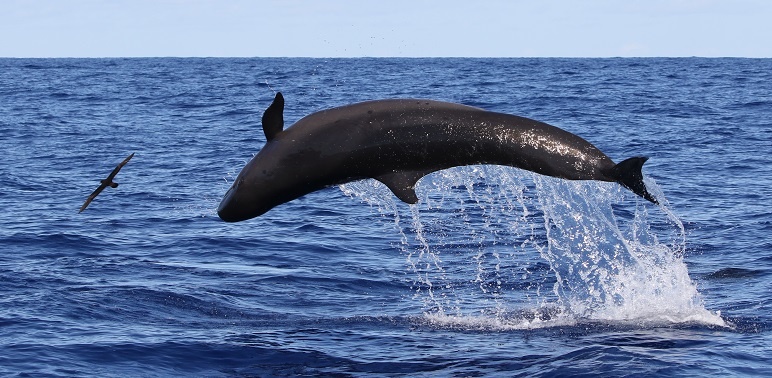
Another Whale Death: For the second time this year, a Hawai‘i deep-set longline vessel killed a false killer whale while fishing for bigeye tuna. The first incident occurred in January within the 200-mile exclusive economic zone around the state and contributed to the National Marine Fisheries Service closing a large section of the zone south of the islands in February.
On March 1, a vessel fishing outside the zone hooked and killed another false killer whale. According to an incident report, the animal was initially seen floating motionless at the ocean surface and upon closer inspection, was found to have been hooked in the tail, with the wire leader and branch line cinched around it.
Despite a federal observer asking the crew to retrieve the captain, the captain chose not to come on deck, telling a crew member that he did not see the whale, the report states.
“As the animal was pulled closer to the boat, bubbles came out of the animal’s mouth, likely from trapped air released as the animal was pulled from the tail. This caused the crew to question whether the animal was still alive,” the report states. Before the animal could be biopsied, the crew decided the animal was too heavy to bring any closer and cut the branch line.
Several days earlier, the fishery hooked what may have been another false killer whale, but the crew kept the line taught and the animal managed to free itself by straightening the hook, which is what is ideally supposed to happen under measures required by the whales’ take reduction plan.
Clean Water Act Watered Down: The Environmental Protection Agency has issued guidance undermining protections that were previously afforded the nation’s waterways under the Clean Water Act.
The guidance, issued April 16, holds that pollution that reaches waters of the United States by means of groundwater flows is not subject to regulation under the Clean Water Act. As the law firm Earthjustice noted, “This formally reverses the [Trump] administration’s position in an upcoming Supreme Court case, Hawai‘i Wildlife Fund v. County of Maui.”
That litigation resulted in a finding by the federal district court in Honolulu, upheld by the 9th U.S. Circuit Court of Appeals, that the county had violated the Clean Water Act by discharging effluent from the Lahaina sewage treatment plant into groundwater, which carried the effluent to nearshore waters.
The county appealed the ruling to the U.S. Supreme Court, which agreed in February to hear the case. While the EPA had filed an amicus brief with the appellate court agreeing that the county’s practice was a violation of the act, the EPA’s new guidance reverses that position. This, Earthjustice stated in a press release, “effectively [gives] chemical plants, concentrated animal feeding operations, oil refiners, and other industrial facilities free rein to discharge pollutants indirectly into the nation’s waterways without Clean Water Act permits.”
In addition to the Hawai‘i Wildlife Fund, the Sierra Club-Maui Group, Surfrider Foundation, and West Maui Preservation Association are plaintiffs in the lawsuit against the county.
David Henkin, the Earthjustice attorney arguing the case, said, “While unsurprising, it is nevertheless disappointing that Trump’s EPA has reversed the position that every other administration – Republican and Democratic – has consistently taken since the Clean Water Act was enacted.”
‘Aina Le‘a Emerges from Bankruptcy: As the hearing date approached for the bankruptcy court hearing on the reorganization plan of ‘Aina Le‘a, Inc., one lone secured creditor was still a holdout. Romspen Investment Corp., which was owed more than $13 million, was unhappy with the debtor’s proposal to pay off its note.
By April 8, however, the date of the hear- ing, ‘Aina Le‘a and Romspen had come to terms acceptable to Romspen, just as the other two major creditors – Bridge ‘Aina Le‘a, LLC, and a Chinese woman, Libo Zhang – had done.
Now all that remains is for ‘Aina Le‘a to give the court evidence of its exit financing and other documents. That will clear the way for final approval of the plan and allow the company to move forward with its efforts to develop the roughly 1,000 acres of land it owns in South Kohala.
If you like what we do, please consider supporting Environment Hawai‘i with a tax-deductible donation.

Leave a Reply